
Private homepage – Hans-Georg Michna
Kenya travel reports: 1999, 2000, 2002, 2003, 2004, 2005, 2006, 2007, 2008, 2009, 2010, 2011, 2012, 2013-Goma, 2013, 2014, 2015, 2016, 2017, 2018, 2019
Kenya Safari Travel Plan, Kenya 1980-2000 photos
Kenya 2003
A personal travel report from Kenya in May and June 2003
Copyright 2003-2023 Hans-Georg Michna.
Click on the small pictures to see them enlarged, usually to 800 x 600 pixels.
Times are given in local Kenyan time in 24h format (without "am" or "pm"), i.e. 0:00 to 23:59 o'clock.
If you cannot play DivX movie clips, install a matching codec. Download (or immediately open) and install a suitable codec filter pack, for example, this. You can then watch the DivX movies through the Windows Media Player or through the Media Player Classic (MPC) that's included with the codec pack.
Alternatively, if you don't want to install any codec, download and install (or just copy) the VideoLAN player (VLC) from www.videolan.org, then download the video by right-clicking the link or picture below and selecting the command Save target as ..., then open the AVI video file in the VLC player.
A few readers had the problem that after clicking on a picture, then going back to the main page, all thumbnail pictures were reloaded. This is typically caused by Internet Explorer cache corruption. It can often be repaired by going to the Internet options and deleting the temporary Internet files.
All photos are subject to copyright . If you want to reuse any photo, send me an email asking for permission, and I can send you the full-size photo, usually 1,600 x 1,200 pixels. Photos bear the copyright 2003-2023 Hans-Georg Michna.
[I will put meta comments, those explaining how this report was created, in brackets.
I have sold my complete camera equipment, a Canon EOS 600 along with a 300 mm zoom (apochromatic), normal and 24 mm wide angle lens, system flash etc. and bought a Panasonic Lumix DMC-FZ1 digital camera (see http://www.steves-digicams.com/2003_reviews/fz1.html for details). This will make it possible to have photos on this web site while I'm travelling. Found that prices for used film-based cameras are approaching zero, but was lucky this time to get a decent price, not much less than the new camera cost.
A big change is that I don't have to tote the heavy camera box any more, which will make my stay much more pleasant. The only real disadvantage is that I could sit on the box, and now I can't do that any more. But the advantages strongly outweigh the disadvantage.
Most photographs in this travel report are reduced to 800 x 600 pixels and JPEG-compressed with medium strength to make them more palatable for the web.]
I'm slowly beginning to pack and read (and edit) my own travelling checklist (in kenya.htm#Preparations and in the old German version kenia.htm#Reisevorbereitungen).
I already have a new international driver's license, even though it isn't absolutely needed. In fact the only few things that I have to make or buy are a smaller bean bag for my new, smaller camera and two pices of insect gauze big enough for the two jeep doors, so I can sleep in the jeep with open windows, but still keep out mosquitos and other small animals of the night. The last time I tried to wedge small pieces into the windows, but that doesn't really work. This time I intend to try to wrap two much larger pieces around the entire upper half of the doors and jam them into the closing doors. That should be easier and more effective. Last year I didn't have big enough pieces.

The flight times are Munich 22:50 06:50 Dubai 08:10 12:05 Nairobi (on Monday). They are considerably longer than any more direct flight, because the United Arab Emirates and Dubai are far to the east. They even have a different time zone, 4 hours east of Greenwich, one more than Kenya.
Munich Airport was almost empty. I didn't have to wait, the economy check-in counter wasn't occupied, and when I lined up at the business class counter, the first class lady waved me over. This was good luck, because she didn't even blink when I put 33 kg luggage, rather than the allowed 20 kg, on the scale.
It turned out, however, that the plane was essentially empty. My first impression was that there were more crew on board than passengers.
The plane to Dubai was an entirely new Airbus A-330 (absolutely clear windows), the second one from Dubai to Nairobi an equally new Boeing 777. Here's the flight route. I tried to sleep after dinner to Dubai, hence no record of that part. It seems, we sneaked around Iraq.
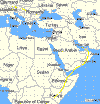
2003-05-11 to 2003-05-12 Munich Dubai Nairobi
I arrived in Dubai in the morning. Due to the two hour time shift the sun had already risen.
I had never been to Dubai, so I took a few photos on the airport. It is quite nice, not too big, and a tad exotic. Shopping seems to be the big thing here. Apparently people fly to Dubai from all over Africa just to go shopping.
After a short wait I boarded the flight to Nairobi. This one was about 2/3 full, but I still managed to find an empty window seat way aft, which I hadn't been able to get when checking in.
This flight was interesting. I took a couple of aerial photographs, the first one showing the Dubai industrial waterfront, then pictures from Oman and Yemen, then, after crossing the Gulf of Aden and flying over Berbera, Somalia, pictures from the Ogaden area, then northeastern Kenya, after cutting through Ethiopia and reaching the pointed northeastern corner of Kenya, actually Kenya's easternmost point. The last one shows the Seven Forks reservoir in central Kenya.
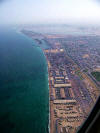





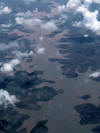
Aerial photographs on the way from Dubai to Nairobi
We soared past Mt. Kenya, but only a massive cloud formation betrayed the mountain's position. Soon afterwards we landed in Nairobi.
After disembarking I walked very briskly past most other passengers, because I wanted to be at the luggage carousel as early as possible. I had to fill a visa form and a new form for SARS control (Severe Atypical Respiratory Syndrome), got the visa ($50), got past SARS control, past immigration, found all of my two pieces of luggage, checked the three banks inside the controlled area for the best rate (they offered 77.1, 77.1, and 78.35 KSh to the euro, central rate was 80), got past two guys who told me that they were after narcotics from south America, got past an inquiring customs official and finally past the hordes of taxi drivers.
Due to a misunderstanding (is 12 pm noon or midnight?) my jeep was not there, but after a telephone call I only had to chat for a while with the lady at the Hertz counter (I always chat with her when I arrive), until the jeep arrived.
The weather was fine, sunshine with a few cumulus clouds.
The driver, who had brought the jeep, took me to Rasul's office and workshop in town where I met Shahid Rasul, with whom I had already been in contact.
He showed me some new GPS receivers and we chatted while his men took the rear seats out of the little Suzuki Sierra jeep, fitted an extra 20 l jerry can (English and Kenyan word for gas or petrol can) because of the bad roads after torrential rains in Kenya. He gave me a sleeping mattress, a tow rope, some tools, and fitted a cigarette lighter, which will provide me with electricity, so I can run my computer and charge my batteries out in the bush (through a 12 V to 230 V inverter).
Shahid also showed me a new type of car, a bit more expensive than the Suzuki, but a lot more comfortable. I may try that one later in June, when my family arrives.
We had a look at the web site (www.rasuls.com) and I planned some slight improvements. The number of seats is now listed for each type of car, and the cars that are not for off-road driving are marked "tarmac", an English and particularly Kenyan word for the material used to make paved roads.
Eventually I jumped into the jeep and drove off, once more getting used to driving on the left side. But I am so used to it that I switch between right and left hand driving effortlessly and no longer make any dangerous mistakes.
I drove over to Wilson Airport, into the Aero Club of East Africa compound, parked my jeep and greeted a few more people. I got my room key and moved the luggage into the room.
SMS (Short Message Service on the mobile phone) had not worked when I was at Rasul's, and it still didn't work in the Aero Club. But after a few more attempts and after some time it suddenly worked and I could send an SMS back home. Perhaps the system needed a few kicks until it starts working again. It did work last year.
Kenya has had unusually late and strong rains. Later in the evening a heavy shower came down over the Aero Club. I waited until the heavy rain subsided, then went to the club restaurant for dinner and finally to bed.
Please note that the Aero Club of East Africa (ACEA) is a private club, "members only", not open to the public, unless guests are accompanied and signed in by a member. This means that I can use the Aero Club for accommodation for friends who travel with me, but when you travel on your own, you can unfortunately not use its services.
After a good night's sleep I woke up to a clear blue sky and sunshine, watched some CNN news (yes, all guest rooms now have TV sets), then strolled across the parking lot to the Aero Club building.
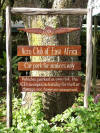


The Aero Club's parking lot and my jeep, still wet from the rain
The Aero Club of East Africa has a new front and entrance. Last year they had begun the work, now it's finished, and it looks much more stylish and has a useful porch now. I like it.
I had a small breakfast (tea, croissant) in the club's restaurant while looking over the airfield and watching some planes take off.
By now the first clouds had already covered about half the sky.
Now it's time to post this on the web, so I'll pay a visit to my favorite Internet caf and check their Internet connection. [Time passes.] Bad luckthey have installed a proxy server that makes web site uploading impossible. I tried two Internet cafs, but both failed to work for me.
But I found out from a knowledgeable person (Naish Malde, director of LGL at Langata Link computers@mailafrica.net) that SwiftKenya (www.swiftkenya.co.ke) offers a telephone number, 0900555555, that always gives you Internet access through an analog modem (no username, no password) by adding 5 KSh per minute to your telephone bill. That's exactly what I needed, and so I can now work from hotel and guest rooms. Except that the telephone connections are often bad, connections drop, etc. But it's still progress. So far I like it. This is how I uploaded most of this page. [This service was later, in 2004, withdrawn and limited to holders of telephone cards.]
It rained again heavily in the evening. The rainy season is still on, apparently.
Not much to report. I wasted some time on Internet problems, then visited some people.
Again there was a heavy rain in the evening. I drove all across Nairobi at dusk in the rain, which was an experience, and later the same way back. Two trucks had collided and half blocked the Valley Road roundabout. Elsewhere the traffic was also very congested and painfully slow. In addition the potholes become invisible when they're full of rainwater. Driving under these conditions is extremely tiresome, because it always demands full concentration. The only good thing was my GPS which led me precisely through the dark alleys of northern Nairobi.
I plan to leave for Baringo tomorrow early in the morning. I already heard that the road is blocked in several places by floods that have taken out at least one bridge. But I hope to get through with the help of the jeep.
After a small, but good breakfast and a last view over Wilson Airport I drove off towards Baringo.
Petrol is cheaper than in Germany, but I need a lot.
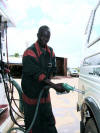
He watched the camera more than the tank.
The map shows the way to Baringo, first along Kenya's backbone road, then off to the north from Nakuru.
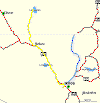
2003-05-15 to 2003-05-16 Nairobi Naivasha Nakuru Baringo
The drive out of Nairobi leads into the highlands, then over the edge deep into the Great Rift Valley.
The Uganda Railway (Mombasa Nairobi Kisumu Kampala) follows roughly the same route, but meanders more strongly because of the slope.
Since I had spent much of the morning in Nairobi, arranging things, I had left only at 11 am. This left me barely enough time to reach Baringo. With this in mind, and with the expected road problems, I decided to spend the night at the Lake Naivasha Country Club (aka Lake Naivasha Hotel, belongs to Block Hotels & Lodges). A few impressions:
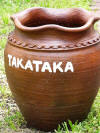
Know your Kiswahili: taka = garbage, takataka = garbage can
On the way to Naivasha I already saw the first zebras from the road.
[For fun, I will try to upload the web page from here. Let's see if this works. (Time passes.) Yes, it did! Things are getting better. They want some money for this though. What happens is that I was asked into the secretary's room, she made a little space for me on her table where I could put my laptop, then she handed me a telephone cable. I dialled the already mentioned SwiftKenya number, and it worked on the first attempt at a speed of 19.2 Kbit/s. Not grand, but not bad either, considering that I'm now in upcountry Kenya.]
The grey sky dampens my enthusiasm for photography somewhat, but on the other hand the number of photographs in this travel report is already frighteningly high. One upside for me is that it's cool. I walk around in a shirt with the sleeves rolled up, and the temperature is perfect. Assuming that I've already gotten used to warmer temperatures, I estimate the temperature at 24C. A light drizzle began, but soon stopped again.
I strolled across the lodge compound down to the lakeshore, watched and listened to the fisheagles, watched the kingfishers catch their evening meal, and enjoyed the last brief sunray coming through a hole in the dark cloud formation over the other side of the lake. It was a very beautiful, quiet evening.
Then I found out what made those funny deep noises above meit was an owl couple, giving me yet another excuse to try to stretch my new zoom to its limits. Finally I stumbled over a wandering ant colony and tried the macro capabilities.

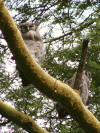

Some animals on the shore of Lake Naivasha
[The first two pictures show the limits of the zoom lens. The fish eagle was taken from a considerable distance at max zoom and cropped, rather than resized. The other two were also taken at zoom or macro limits and also mostly cropped, then minimally resized. I hope that such brief technical remarks do not distract too much from the wonderful experience of African nature, which is the real center of my attention.]
A tasty five course dinner ended my day.
Early in the morning I had a good breakfast, then set off for Baringo.
The overshadowing event was the flood. There was water nearly everywhere, even in otherwise dry areas. There had been lots of rain, and there is currently no end in sight. Even in Baringo it rained in the evening. I have yet to experience a single day when it doesn't rain at least in the evening.
I drove the short distance back to the main road, turned left towards Nakuru, and after less than 1 km ran into the first obstacle. A stream of water was flowing across the road and had apparently already damaged it. Police were there and regulated the one lane traffic through the water (first two photographs below).
I drove past Nakuru and turned off the main road to the north, to Baringo. Along the way I saw more flooding.
At one point I almost killed a sheep. It walked to the edge of the road, then bowed down and started to graze. But as I had almost reached it, it suddenly continued to walk onto the street. I swerved to the right, braked hard, and narrowly avoided it. I learned two lessons here:
I later asked about the value of a sheep, which is about KSh 700 to 1,000 (around 10). Goats can be more expensive, even up to KSh 2,000, and a good cow can be worth KSh 6,000 to 10,000 or more. On the other hand, the law says that the keeper is responsible, unless his animals cross the road at predetermined, marked crossings. So the practical rule is: if you overrun some livestock, pay only if there is a mob threatening you.
Eventually I reached the Baringo area and could see Lake Baringo from the road.
The last town before Baringo is Marigat. I watched people boarding a bus and other people trying to sell them fresh fruit. About 20 km before Marigat my mobile phone stopped working.
At the bus station by lucky coincidence I met Asha, who was also heading for Baringo. She had come from Nakuru. Had we known each other's itineraries, we could have met already there. Asha was the girl and is now the woman and mother whose school fees I had paid for many years.
In several places north of Marigat the floods had damaged the road. One bridge was blocked because it was damaged so much that any next vehicle crossing could make it break down. In another place a 20 meter section of the road had simply been pushed away (second photo below). Here the river had changed its course entirely and caused more damage downstream where it shoved away peoples' housing.
Finally I got to Baringo and visited some people.
I actually managed to get a mobile phone connection in carefully selected places. Difficult, but possible. I even sent and received SMS text messages to and from home.
I looked also for Chemandazi (please see last year's report and the epilogue), but she had gone home into Pokot country, far from any road. I will try to find out whether there is any way for me to find her, but it seems to be very difficult. I'll give this another try tomorrow.
The project I'm visiting here is the Rehabilitation of Arid Environments (RAE) Trust (see http://www.raetrust.org/). After another nice breakfast out in the open, overlooking the lake, I was invited to a survey of some of the managed fields where people prepared the soil for sowing a breed of grass that is particularly suited to the hot drylands. Two people with geodesic equipment measured the altitude profile of the field, then a tractor with a special plough drove along lines of constant height digging parallel ditches, so the rainwater, if any, does not flow off but is instead caught in level ditches.
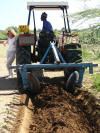
A special plough that produces two parallel ditches
We had a walk around neighboring fields that were not yet prepared and along a creek that carried a small amount of water through the fields.
These fields are fenced either with Opuntia cactae or with an electric fence or both to make sure the goats cannot come in and overgraze the area like they do in most other places around here that are essentially a desert.
The sky was blue with hardly any clouds visible and the heat even in the morning was such that the sweat ran down my face. I believe I couldn't have continued much longer before I would have run the very real risk of a heat stroke. Only the occasional light breeze cooled me down a little.
In the afternoon I did a little computer work for my hosts, properly set up an email client, and finally tried to get to my own email and upload this web site. However the connection is so poor that my, admittedly less than perfect, notebook softmodem could make its first connection only after I had throttled it down to 2,400 bit/s. But even that connection kept breaking off before I could download a single mail. The telephone line runs over a microwave connection from Baringo to a place near Nakuru, and the quality is simply too bad for any normal modem connection.
I had known this, but I had not really believed it. Now I have experienced it myself, which was a useful lesson to me. For people like me, who are used to always-on broadband connections, this had been just too hard to believe.
Unfortunately there is practically no alternative for any reasonable price. Even the best modems have severe trouble to keep any usable connection for any longer time under these conditions.
At least I could get a mobile phone connection by climbing onto the water tank that towers over the buildings on the top of the steep shore. This allowed me to call the people I was to meet next and make an appointment.
Chemandazi remained out of reach. It could have taken me a day to find her far out in the bush, but I don't speak Pokot, not everybody might know her or her family, the way through the bush could well be unpassable due to the rains, and so I finally had to give up, but the gifts I brought will reach her later when she visits the clinic again. I have a series of new pictures though, and you can see them in the photographic epilogue.
Later I prepared my bed for the night by releasing the mosquito net. A big, very beautiful dragonfly landed on it.
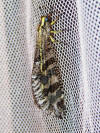
The dragonfly (original length 8 cm ~ 3 in.)
Then I took a brief shower to get rid of the sticky, sweaty feeling. To my horror there was a big beetle circling around the light in the bathroom, so undressing and taking the shower required constant attention to avoid a collision. Eventually the beetle landed on the lamp, left me in peace, and later fell crashing down because it was too slow to open its wings in time.
Finally I crawled under the big mosquito net into my big, nice bed and slept deeply throughout the full moon night with all windows wide open.
In the morning I took some photos of the house where I had been accepted as a guest.
I find the architecture of this house very impressive. It shows that it is possible to join African tradition with modern taste and requirements and arrive at a wonderful combination of both.
My hosts and I had breakfast at the edge of the steep lake shore.
After breakfast I still did several little things that ended up taking the entire morning. My plan had been to get to Samburu, but driving all the way to Samburu in one afternoon is impossible. Therefore I planned to reach Maralal and spend the night there.
I drove north past the lake, then turned right (to the east) at Loruk. The track goes up into the hills north of the lake (see first two pictures below), climbs out of the Great Rift Valley, then heads east through Tangulbei, Churo, Mugie, Kisima to Maralal.





Driving from Lake Baringo to Maralal
Much of the way was good to drive, sometimes even at or above 50 km/h (31 mph), but in some places I had to cross ditches that the water had washed out. In others the ground was rocky and very rough, such that I had to drive in first gear, idling speed, somewhat slower than walking. Fuel consumption rose to about 8 l / 100 km, but there is a petrol station in Maralal.
I saw more zebras and the first ostrich.
I wanted to check out Yare Camel Club, a little private lodge run by one Malcolm Gascoigne. Indeed I met him in the lodge compound, where he was having a barbecue with some guests, the DC (district commissioner) among them. He immediately invited me to join in, and I had a very nice dinner with the best grilled pork I can remember.



The evening view to and from Yare Camel Club
After some chatting with the guests, three German development aid people among them, I retreated into my little hut. There were no mosquito nets, but Maralal, over 1,900 m high, is too cool for mosquitos or at least for malaria.
The accommodation was basic, but acceptable, and much cheaper than the normal tourist lodges. The price for a single room is KSh 700 for residents and $15 for non-residents. This includes bed, toilet, hot shower (warm water only in the morning after letting the water run for at least 5 minutes), but not the food. The restaurant is OK though, but opens only at 8 am, so I left at 7 the next morning without breakfast.
This is perhaps the most beautiful and exotic part of the drive. It leads through the hills to the east of the Rift Valley, then into the flat lands of the Samburu.
The following photos try to show what the way looks like. The air was so clear that I could see Mt. Kenya in the distance when I was higher up. (You can see the mountain in the background of the second photo below.) Somewhere along the way I picked up a hitchhiker who turned out to be the local chief, on his way to a meeting in Wamba. As Wamba is not far from my route, I took him there and used the occasion to buy two mandazi (something similar to a doughnut) and a bottle of Sprite.





The road to Wamba (note Mt. Kenya in the background of the second photo)
In the dry areas to the north of Kenya people use camels.
On the way back from Wamba I had to brake hard to avoid rolling over a chameleon that moved in its very peculiar way back and forth, imitating something that's being blown by the wind.

How did the chameleon cross the road?
These two guys are Samburu warriors in traditional dress.
Driving over a river crossing, I saw this Samburu mother with her son getting water from a hole in the dry riverbed. I stopped to watch and said to her, "Maji" (water), just to say something. But she misunderstood my friendly conversation attempt and thought I was asking her for water. So she carefully extracted a cup of water from the hole and told her son to bring it to me.

Getting water from a hole in a dry riverbed
This had not been my intention, and I wasn't going to drink this water. But I didn't want to be ungrateful either, so I opened the hood of the car and poured some water into the cooler (which was a bit low anyway). Then I thanked the boy and his mother and gave the boy a KSh 5 coin. This made him very happy. He shouted down to his mother that he had got shillings for the water. I still don't know whether I perhaps shouldn't have done this, but at least it was no begging transaction.
Not far from the river crossing is the turnoff towards the Samburu west gate. The road leads to Archer's Post, but I turned right towards the south. This turnoff is easy to miss.
Now the track became more difficult. On the way from Wamba to Samburu I have actually used each and every single one of the jeep's 10 gears. Most of the time I was in the second and third fast, two-wheel-drive gear, but several times I had to use the four-wheel drive to get through deep sand, sometimes in riverbeds, or through a mudhole.
The track passes by some ruins, or rather a ghost town of buildings including a church, that had been half built and then abandoned. The name of the nearest place I could find was Ngotogongoron. The whole area was very green, which is rather uncommon. Normally when I drive here, everything is dry and brown.
Later I came closer to the Ewaso Ngiro river, also called Samburu River. I had to cross a series of dry riverbeds of tributaries.
Eventually I reached the Samburu west gate and paid my entrance fee. Shortly afterwards I crossed a dry riverbed again and saw some children getting water from a hole they had dug into the riverbed.

Children getting water from the ground of the riverbed
Most of them wore their school uniforms. One of the motives for having school uniforms at all is to make poor children indistinguishable from richer ones.

Samburu girls in school uniform
The next obstacle was a big elephant bull and a youngster following him. The big one walked along the track, so I had to stop and wait until he turned off into the bush, which he duly did. I couldn't take any good photographs, because he was showing me only his back side. (Perhaps this warrants the general remark that I don't take photos of everything, just to illustrate this report. Instead I restrict myself to those photos that I consider to be of reasonably good quality.)
After that I drove straight to Samburu Lodge and asked for a room. It turned out that there were only four guests in the entire lodge, partly because British Airways and some tourists had stopped flying to Kenya because of a terrorist scare. Two of the guests were an elderly couple from Mexico, the other two were two women of Indian origin from Great Britain.
I still got lunch, rested a bit, then drove out for a short evening game drive. The river had a lot of water, considering that only a few years ago I had driven around in its dry bed with my jeep.
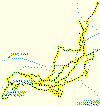
2003-05-19 and 2003-05-20 Samburu game drives
Some first Samburu impressions:

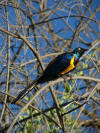

Tortoise; golden-breasted starling; impala buck
In the evening I got a chance to see some crocodiles outside the water.



Nile crocodiles on the shore of Samburu River
Then I had a six course dinner, chatted for a while with the two ladies from England (greetings if you happen to read thisplease send me an email), then retreated to continue writing this report and going to bed early.
I drove out at sunrise and then again after breakfast. I saw many kinds of animals, but due to the fresh, high grass the animals could also hide very easily.
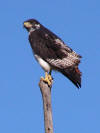

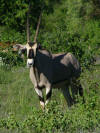
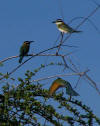
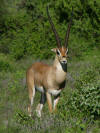
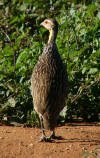
Augur buzzard; secretary bird; oryx; white-throated bee eaters; Grant's gazelle;
yellow-necked spurfowl
In the end, however, this became the day of the elephants.
[I couldn't resist trying another camera featurethe movie, and even with sound. You need Apple's QuickTime installed to watch the motion. The movies require approx 1.5 Mbit/s for streaming, but if your connection is slower, you can still download them and watch them offline.]
Many elephants were crossing the river from south to north that morning. Most of the time I drove along the river bank and watched out for elephant groups.

Movie: Elephants crossing the river
File formats: DivX (AVI, 2.58 MB)
If you can't see the DivX video, install a suitable codec filter pack, for example,
this.


An elephant group crossing; two elephant bulls in the water
Two bulls were sparring in the water.

Movie: Two elephant bulls sparring
File formats: DivX (AVI, 1.19 MB)
If you can't see the DivX video, install a suitable codec filter pack, for example,
this.
After I initially thought I would hardly see any animals in the fresh, high growth after the strong rains, my expectations were vastly exceeded.
Some more photographs:
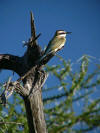
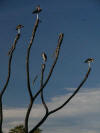
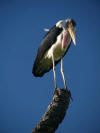

White-throated bee eater, marabu storks, crocodile
The food is ample and quite good, usually 5 to 6 courses, all served at the table.
This morning the other four guests left. Four new ones came, a couple, probably spanish, they don't seem to speak English very well, and an Egyptian couple on their honeymoon safari, he from Cairo, she from Alexandria. I later got invited to their dinner table, and we had a nice conversation. (Please send me an email, if you ever happen to read this.)
I will probably stay here for a third night. Samburu is so beautiful that it would be a sin to leave after only one full day in this wonderful nature reserve.
Because Samburu is so beautiful and interesting, and also because it has yielded so many nice photographs, I have decided to spend a third night here, staying for today, and leaving tomorrow, on Thursday. So there are some more photographs.

2003-05-21 Samburu game drives


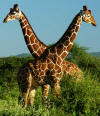


Dikdik, two pairs of reticulated giraffe, crocodile, monitor lizard
The dikdik is the smallest gazelle in east Africa. Note the dark glands in front of the eyes. They are used to mark their territory. They live in pairs with each pair occupying a territory.
On a dead tree I found this most peculiar little creative monster. I don't know what it really is, but it covers all of its body except the antennae with little bits and pieces of crap. I suspect it's a predator, disguising itself as a piece of rubbish.

Little creative monster (original length 1 cm)
In the afternoon it happened to me twice that I came to a place on the riverbank where elephants were crossing the river from the other side, and they walked exactly to the place where I appeared, more precisely, my jeep.
The first time it was a whole group of elephants in the water. They stopped when they saw me, but they had already almost reached my side of the river. I always try to be polite to elephants, so I reversed and cleared their path before being able to take a photograph.
The second time it was a single adult bull. He didn't stop, but didn't show any signs of agitation either. I moved out of his way anyway, again before being able to take a photo. Too bad! They all looked very good, as elephants always do when they walk straight towards you.
More pictures from the afternoon:


Pale chanting goshawk (immature), more elephants crossing the river
Dawn and dusk under the equator are short. It takes about half an hour from sunset to a starry night. The following pictures were taken around sunset. The crowned cranes caught the last glimpse of sunlight. The lioness was photographed when it was already half dark, and when I photographed the eagle, it was already mostly dark.
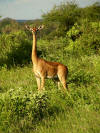


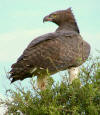
A female gerenuk (giraffe gazelle), crowned cranes, lioness, martial eagle
[It seems that the camera does reasonably well in low light, but below a certain level it becomes entirely unusable because it can't focus.]
For now my time in Samburu is up. Perhaps I'll see some more interesting animals tomorrow morning when I drive out.
I woke up around 5:30, took a shower and changed clothes to remove most of the dust I had collected. I intend to drive off at sunrise, after paying my lodge bill (by credit card). And so I did.
I found that one of my ways was blocked by a river. Most likely it was passable, because the drivethrough is stony, but I didn't want to risk getting stuck. So I stood there for a time and pondered the idea of checking the drivethrough by wading through it bare footed, but then I didn't want to take any risks, turned back, and took a different path.
The road to Isiolo was worse than ever. I had to drive long stretches at around 20 km/h. But eventually I reached Isiolo.
My way then went to the west of Mt. Kenya, through Nanyuki and Thika to Nairobi. There things didn't go too well. All rooms in the Aero Club were taken. When I tried to reach a friend where I could have stayed, the daylight disappeared, and a fresh rain made the tracks to the somewhat remote place so slippery that I had to turn back. Thus I had the joy of driving along the Magadi road, through Ongata Rongai, Kiserian, and Oloisiusiu, twice at night. Then the hotel I wanted to go to (the Park Place Hotel), which is on the way, turned out to be closed for good.
Driving near and through towns at night is an experience that is difficult to describe. It is so dangerous that I don't recommend it and avoid it myself, if possible. This time it was exacerbated by previous rain that fills the potholes and makes them invisible.
The road is, of course, unlit and so narrow that my jeep can just barely pass an oncoming truck, but the edges of the tarmac are often broken in, so you have to drive so slowly that you can still stop when a hole appears in the dim and short headlight in front of you. Most other drivers, of course, know each pothole, so they know exactly where they can drive fast.
However, people also walk on the road. Particularly after the rain the slippery, clay-like soil next to the road is almost impossible to walk on without slipping, so people take to walking on the edge of the road. They hope that cars can avoid them. When they see two cars coming in both directions, or side by side, they often, but not always, jump off the road.
The worst I saw was a heavy, fully loaded, two-wheeled cart, pulled by a man. Of course it had no lights whatsoever, and the man didn't take it off the road, because he wouldn't have been able to pull it back up again. I could narrowly avoid him, but I think that his chances of survival are severely diminished. Trouble is, the reason why he does this is that his chances of survival are also severely diminished if he doesn't do it. He obviously needs the money pretty badly that this job earns him.
One method to stay out of the worst trouble during such night drives is to wait for another car that has working lights and drives slowly. Then follow it. That's what I did most of the time, but the other cars have this annoying habit of suddenly turning off or stopping, so I again end up alone in my lane. The ever-present matatus (privately run minibusses that carry passengers and stop often) of course drive much too fast for me. Their drivers can probably drive their routes blindfolded.
[Sorry, no pictures of all thisI was too busy keeping myself alive during those night drives. Also, the flash on my new camera doesn't reach very far.]
I ended up in the Fairview Hotel, always a good backup. However, I could not get to the Internet with my computer from there. They have a strange telephone system. So I went to bed after only recharging all the batteries as usual (GPS, camera, computer).
The Fairview Hotel appears to have evolved from a nice second class hotel into a nice first class hotel. Unfortunately the prices have also risen. The cheapest single room went for KSh 5,200, notably more than the wildlife lodges I have visited.
But I found everything (except the missing Internet connection for my computer) truly first rate. Of course the have a business center with Internet connection, but I cannot connect my own computer there. Some impressions:




Fairview Hotel Nairobi, the breakfast buffet on the right
After breakfast I moved to Langata Link, where I found, at the third try, a usable Internet connection. Had to filter out the meaningful 33 emails from 421 in total, the rest of which was spam. This, and the uploading of this web page, particularly the movie files, took many hours.
Later, in the afternoon, I moved over to the house at the Rift Valley (please see last year's travel report for pictures). We did some conceptual work on the elephant database, and I spent the night there.
This year's Annual General Meeting happened to be today, so for once I could attend. Compared to other clubs I know, there were few people there, fitting easily in the main room (see earlier picture) and the meeting proceeded quickly and very smoothly. After the meeting I heard about a new project taking shape, called Orly. It is a new airfield south of Wilson, just outside the Nairobi Control Zone, that has been built and is awaiting official approval within the next few weeks. I remain curious.
My hope that the rains have ended has proven untrue. Now it again rains every day. Not much, but sometimes a bit heavier in the evening. The problem is not that I can't go out. The problem is that some tracks in the bush are now probably unpassable, rivers that are usually dry at this time of the year now carry water, and I have to be more careful not to get stuck in the wrong place.
Plans are shifting. I'm still in Nairobi and will probably stay here until at least tomorrow because of a checkout flight and another elephant research meeting.
In Kenya, when a public holiday falls on a weekend, the Monday becomes a public holiday too. Isn't that nice? Wish we had that in Germany. This happens on June 1st, which is Madaraka Day in Kenya, and happens to be a Sunday, so on Monday everything will still be closed. Therefore I'll try to stay out of Nairobi until after that date and will try to spend that time in Maasai Mara.
Then I got an invitation from my hosts for the next few nights to join them at a dog competition in the Kenya Kennel Club in Jamhuri Park, a couple of kilometers to the east of the city center. I gladly accepted, checked out of the Aero Club, and drove to Jamhuri Park.
Some British customs survive at least as well in the diaspora as back home, and dog competitions like this may be one of them. The judge, a lady, had been flown in from the UK to ensure competent judgment.

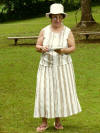
Proud owners handling and showing their dogs, the judge
A special event was the competition of the junior dog handlers. Children are always good for cute photos, so I used the event with joy.

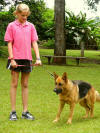
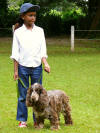
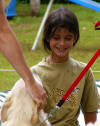
Children dog handlers competition
Finally, in the late afternoon, the winners were honored, first those in each group of dog races (toy, utility, etc.), later the overall winners.
The entire event had the characteristics of a garden party. People had brought their foldable chairs, sunroofs, and picnics, but there was also a bar and free cake (I still remember the very tasty carrot cake) that some participants had donated.
Today I finally got the checkout flight with the Cessna 182 I later want to use to fly to Lamu. When you ask somebody to rent you an aeroplane, they always want to see whether you can fly it safely.
I flew with Ashif Lalani, a young professional pilot of Indian origin, who is on his way to become a flying instructor. Many pilots use countries like Kenya as a stepping stone to the big airlines. They fly tourists in smaller airplanes and gather experience. Pilot salaries in Kenya are not very high, but this sacrifice has to be made to get into the better paid jobs later.
His checkout was comparably thorough, with 6 touch and go landings and one full stop. Among them were two landings without flaps, one spot landing "on the numbers" (the big runway designator numbers painted on the beginning of the runway) like on an aircraft carrier, on runway 07, and one on runway 14, which has a more difficult approach, shorter and somewhat steeper, due to some prohibitions to avoid some areas and to overfly Kenyatta Hospital at a minimum heigt of 365 ft (110 m) above ground.
There was hardly any wind, therefore also no turbulence, and so it was easy to make gentle and precise landings. I did hit those numbers. The following map shows my movements by car and also the circuits with the aeroplane around Wilson Airport. The shape of the circuits is not rectangular, because one tries to avoid built-up areas after takeoff.
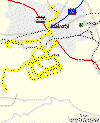
Circuits around Wilson Airport
On my way back to my hosts I had to drive through the whole city, because they live at the northern edge of Nairobi. I thought I should perhaps take a few photos of the Nairobi streets, so I took the camera while driving and tried my luck.
The first picture shows Uhuru Highway, coming from the south and just reaching the city, which is on the right. The picture was taken from the point where the road is elevated to cross the Uganda Railway tracks.
At the traffic lights and roundabouts some people always try to either sell something to the drivers or to beg. This picture shows a begging street child looking curiously into a car.
After passing the core of the city, the environment becomes greener, and some of the roadsides have little fruit and vegetable markets that are so typical of Africa.
I ended up at my hosts' place and will now spend some time to write down this report and upload it. Martin Wei just sent me an email with the precise names of the birds pictured in this report, and one was contributed by Dave Patterson. Thanks a lot, I've now put them all in. Here's a detail from the glass table in the living room. The two figures were made by Frank Meisler from Israel. Check the fly on the frog's back.
We departed in a Piper Cherokee Pathfinder 235 at around 10:30 from Wilson Airport.
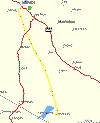
2003-05-27 to 2003-05-28 Nairobi Amboseli
Soon we reached Amboseli. For the first time in my life I saw Lake Amboseli as a real lake with water, because at all earlier times when I saw it, it had been totally dry and I drove through it with the car.
We flew an approach circuit that lead us over Amboseli swamp.

Amboseli swamp with Observation Hill (top left)
Finally we landed at Amboseli airfield.


Final approach to Amboseli airfield, parked plane
Two jeeps were already waiting for us and took us to the camp. There we had lunch, prepared by the resourceful cook and later had a discussion about extensions and modifications to the elephant observations database, which was the main purpose of our visit.
I also learned about what had happened to Erin, one of the adult elephant cows (age 32) of the famous family of Echo. There have been two television documentaries about this particular family group and a third is in the making at this time. The film maker is now here, he's a true one-man show.
Erin got badly speared by some Maasai, possibly for sport, because no other reason comes easily to mind. The veterinaries darted and treated her twice, but she developed septicemia, lived through weeks of terrible pain with some of the researchers staying with her, often for 12 hours continuously, but eventually she succumbed to her injuries and died.
Erin had been one of the most important members of Echo's group. No member of this family had been taken by humans for many years, so this was a bad experience for the other elephants in the group even more than for the humans observing her suffering and dying. A full report of the incident can be found here.
In the evening I watched the stars and then the Milky Way appear. Out here in the bush, with no stray light from cities spoiling the natural view, the stars and the Milky Way are extremely clearly visible. The beauty of the African night is indescribableas a city dweller in an industrial country you have to see it to believe it.

Sunset over my tent at Amboseli and over Kilimanjaro
After dark (sunset is around 18:30, and by about 19 o'clock it is totally dark) we all met in the dinner tent, and some of the funniest stories were told amid laughter deep into the night.
Finally we went to our tents, and I slept peacefully until the first signs of dawn.
I woke up at dawn, shortly before sunrise, and got up even before the cook brought the morning tea into my tent. The night had been quiet. I heard neither lions nor elephants nor the notorious buffalos that tend to walk about the camp at night.
In the morning we had a meeting where one of the researchers explained the current situation regarding DNA analysis. DNA from dung samples is used to identify the degree of relatedness of elephants (through microsatellite repetition counting, just like in forensic analyses on humans). Through this method, which is quite tedious because of the varying quality of the samples, it is possible to prove whether two elephants are closely related, like siblings, sons, daughters. It may also be possible to find out correlations between relatedness and behavior, such as more cooperation between more closely related individuals or families. Research is still in its beginnings, so results could come in a few years.
After some more discussions and having lunch with a group of visitors, we slowly got going to Amboseli airfield again and departed for a flight in very beautiful weather, sunny with some cumulus clouds, for Nairobi.
A wonderful dinner closed the day. My hosts' cook takes much pride in her work. She reads lots of cookbooks, invents new combinations every day and creates a handwritten menu. This household is blessed.
After one last Internet connection and a good breakfast I throw my bags back into the jeep and leave my hosts at 8:30. Since they live in Limuru Road, I don't have to drive back into the city. Instead I can drive along Limuru Road outbound. This road crosses the new Nairobi Nakuru highway and leads down into the Rift Valley to Mai Mahiu. This last part I had already used in my earlier tour to Baringo.

2003-05-29 Nairobi Maasai Mara
It had rained through the night, and I left in drizzling rain that continued all the way to just before Mai Mahiu, where the road to Narok and Maasai Mara branches off to the left. But first the road climbs higher and higher. At 2.000 m I reach the clouds and from now on drive in fog. At 2.300 m I reach the edge of the Rift Valley and now drive down the escarpment again.
![]()
Foggy junction, booths, matatus
In Mai Mahiu I see the sun for the first time this day. I have my tank filled and turn left into the road to Narok.
I drive across the Rift Valley, over the foot of Mt. Suswa, then up again on the other side. The Rift Valley is here approximately 50 km wide.
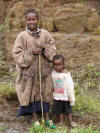
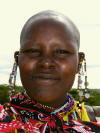
Some people along the way: children and a young Maasai woman
I take a hitch-hiker along for some part of the way, a Maasai woman who speaks no English and not much more Kiswahili than I do, and she leaves again at a turnoff, while I continue to Narok.
The road around Narok and particularly around Ntulelei is rather bad. I have to drive long distances in second gear at a slow bicycle, sometimes pedestrian speed. I reach Narok after 4 hours of slow and mostly leisurely driving with photo stops.
In Narok I top up the tank once more and buy some food and drinks for the case that I camp out. I have not yet decided what I will do and where exactly I will go, but Fig Tree, one of my favorite tented lodges, is a prime contender.
After another 2 hours I reach Sekenani gate, one of the entry points into Maasai Mara. To my surprise they don't do anything, they don't demand the entrance fee, and they apparently don't register my car. Instead I am told to pay later at the lodge.
My drive into Maasai Mara is, as always, breathtaking. I can oversee the vast landscape that stretches to the far escarpment at the horizon. Giraffes wander, a big herd of buffalos catches my attention.
I leave the main road and drive into the bush on barely recognizable car tracks. At first I have no problems with water or mud. As I later hear, there had been some heavy rains, but for the last two weeks it has been dry. But later I need to cross two rivers, and this turns out to be a challenge. Several crossings are unpassable, or at least I cannot find out for sure whether they are passable.
The river crossing in this picture seems too risky at first, but it helps to be creative. After walking along the river and checking the situation it suddenly dawns on me that I can safely drive over the rocks (to the left of the mudhole in the picture above).
In other places I have to drive along the river until I find a suitable place to cross. My ad hoc route leads me through areas that few tourist cars touch. At one time I drive along a bushy creek, thinking about something, and then I remember that I should not give up looking for interesting animals. I look around again and see lionsin the mirror. I had passed them at a distance of about 4 mmore closely than I would normally drive to lionsand not seen them. I turn the jeep around, drive back, and before reaching them I have to leave the track on which I just passed them to avoid getting too close for their comfort.
It is possible that they ducked down when I approached and only raised their heads after I had passed, but I still find it embarrassing to drive past six lions at such a short distance without seeing them. I wonder how many more I have passed.
The lions are watching some antelopes about half a kilometer away. They are hungry. None of them shows the typical belly that lions show after a good meal. Some are still adolescent, but there are no babies any more. During and after the rains lion babies often die. Lions have a simple, but cruel method of population controlthe strongest one always eats first. If there is not enough food, the youngest die.
After a long while I leave the lions to look for other animals, but I return to them once more at sunset. I have Fig Tree on the GPS, so driving there at dusk should be no problemor so I thought.
After sunset I drive off for the second time and retrace the part of my route towards Fig Tree that I had already driven an hour earlier. On my way I find a minibus that got stuck in a mud track that the driver did not see in the grass or perhaps underestimated. I turn off my way and drive over to help them, but before my help was needed, they were able to back out on their own.
They also drive to Fig Tree, so I follow them at a short distance. However, not very far from the lodge they get stuck again. It turns out that the area around Fig Tree is particularly soaked from the earlier rains. They have a tow rope, and it is even longer than mine, so I use theirs to pull the bus back out of the mud. But as I pull the minibus, it keeps getting stuck, so I increase the force until the tow rope tears with a loud bang. A jeep, even a small one like my Suzuki, can produce incredible forces in slow gear and four wheel drive engaged. Fortunately they could still continue on their own, and so we drive a detour towards Fig Tree that avoids the worst mud.
While walking around the cars I had mistakenly put my foot into the mud. The soil here is called Black Cotton Soil, and two weeks after the rains it has a consistency that keeps your shoe, once you dare to step into it. I had to pull very, very hard to regain my left shoe, and later in the lodge it took me a long time and a lot of hot water to get the mud off my shoes and then my fingernails. This stuff is incredible.
But eventually I place the now wet shoes on the terrace before my tent, put on my spare shoes, and walk over to the dinner tent.
Fig Tree has never been particularly famous for its cooking, but the food is edible and occasionally tasty. The receptionist recognizes me, and we later have a chat at the fireplace on the terrace between the dining room, the bar, and the footbridge over the river Talek, which flows almost all the way around the lodge. Finally some Maasai dancers entertain the few tourists with a song and a dance.
After leaving the fireplace, I retreat into my comfortable tent and use the last minutes before the generator is switched off to recharge my batteries in the computer, the GPS, and the camera, and to continue writing this report.
Fig Tree derives its name from the many strangler figs that surround it. The lodge was built into a loop of Talek River and has only one narrow entry from outside Maasai Mara, but it has a footbridge over the river that leads to a parking place inside the nature reserve.
The strangler fig is a plant that begins its life as a parasite on the host tree. It drives roots into its host and steals its sap and nutrients.
After many years it surrounds its host almost entirely and also drives its own roots into the ground, such that after the host tree dies it can now lead a life on its own.
The tents and cabins face outward towards Talek River, so when you sit on the front porch, you're only about three meters away from the slope down to the river. The following picture shows the last tents on that side where the river already bends back. In the other direction the river loops almost entirely around the lodge compound.

Talek River (left) and tents (right)
Fig Tree sticks out among most lodges by being cheaper than most, but still managing to keep a decent quality and an enticing atmosphere. The lower price essentially translates into a somewhat lesser food choice and quality and into electricity and warm water only being available in the morning and evening. But I can live with these small limitations, and I don't mind paying less. Its location at the eastern end of Maasai Mara is also very convenient for those getting there by car.





Dining room detail, fireplace, swimming pool, tent outside and inside
The tents are built under a thatched roof and also have a bathroom with shower attached to them (see entrance to the bathroom in the last picture above on the left side).
I spent most of the day between meals out in the bush. I saw a picture book lion family, father, mother, two very small cubs, but they were to deep in the high grass to take any good photographs. I also drove back to where I had seen the six lionesses last night, but of course they were not in the same place any more.

2003-05-30 Maasai Mara Fig Tree game drives
Here's some of what I saw:
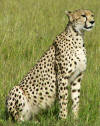


Cheetahs, a mother with her two adolescent cubs



Lioness with wildebeest kill, vultures waiting

Thompson gazelle mother, letting her child drink
I saw a long-tailed mongoose, but it hid before I could photograph it, and I also saw a whole family of white-tailed mongoose, but it was already too dark for a photo.
I woke up before 6, took a shower before sunrise, and drove out again with John Leshaun, the Maasai who works at the lodge as some kind of animator. He's there to convey some cultural flavor, and he's always dressed in traditional Maasai outfit.
We're a good team. He has incredibly good eyes and he likes to drive, though he has no driver's license. Even when he drives, he sees more animals than I do, so I gladly concentrate on the photography while he does all the hard work. Some results follow.

2003-05-31 Maasai Mara, Fig Tree game drives
Jackals are very shy and often run away, except sometimes in the early morning.
Elephant bulls, unlike elephant cows, do not always secrete from the glands behind the eyes. They only do this during a period in the year called musth. During that time they become more aggressive, their rank increases, and with it their chances to mate. This elephant bull in musth has already broken off both his tusks. He showed signs of agitation and blocked our way for some time, but eventually he moved on.

Elephant bull drinking from a waterhole
East Africa has a very large number of bird species, some of which are conspicuously beautiful. They are often shy and difficult to photograph, therefore I cannot really show all their variety.

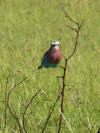
Wattled plover, lilac-breasted roller
One thing that keeps impressing me particularly in Maasai Mara is the wide savannah landscape. Some of the photos try to convey this. Maasai Mara is the northern extension of the Serengeti plains and sometimes I find myself in places where the grass plain stretches from horizon to horizon.



Giraffe, Thompson gazelles and topis, 4 topis
One of the shyest animals is the eland. Even at a distance of several hundred meters they move away from anything unfamiliar, and very unfortunately this includes my jeep.


Eland, Thompson gazelles with elands moving in the background
Already on the way home from the early morning game drive we happened upon three old acquaintances, the three brothers, all of whom are still alive and well.


The three brothers arrive, one of them
My lunch and dinner portions become ever smaller as I get used to this abundance of food. One advantage of this is that I am not so lazy after lunch and can drive out earlier, i.e. some time before 16 o'clock. So here are a few more photos.


Two female waterbucks, hippos in Talek River
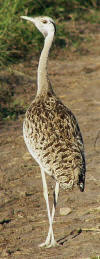
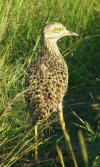
Black-bellied bustard, spotted stone curlew (German name: Triel)
After a good dinner I sit down at the fireplace and chat with a young man from California, of Indian origin, working on the mobile phone system. He told me that the company is required to put stations in some lodges, but reduce the range, so it does not cover the entire reserve, but only a small area around each lodge. Technically it would be easier and cheaper to cover all of Maasai Mara with the existing stations, and it's only a change in the transmitter settings that takes about a minute to make.
He doesn't know why this is so. Not that I like ringing mobile phones in a nature reserve, but people could be required to switch them silent or off and use them only in an emergency or in their rooms in the lodges, if the motive is to protect tourists from each other. Since getting stuck in a remote corner carries a definite risk of death when one has to walk out, for example by being killed by a lion, a buffalo, or a snake, it is astounding that this kind of protection goes as far as risking human life, particularly when taking into account that the nature reserves like Amboseli, Samburu, or Maasai Mara are otherwise anything but well protected, not even from massive intrusion of Maasai or Samburu cattle and goats, which are by far the biggest herds of animals in these parks. Today alone I drove past four huge herds. Anyway, I would like to know the reasoning behind the mobile phone restrictions, as I cannot conceive of any that makes sense to me. I am personally affected, because I have put off buying a satellite phone in the expectation that mobile phone coverage would soon make it unnecessary. But the rule seems to be that one should bypass Kenyan infrastructure, wherever possible.
Early in the morning, around 6:30, I saw the first balloon this time. Usually Maasai Mara is full of them in the mornings, but with tourism being far down there don't seem to be enough people to fill one every day.
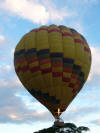
Hot air balloon taking off from Fig Tree
I later met the balloon pilot and we chatted a bit. He mentioned that he had also hoped for mobile phone coverage, because his VHF radio doesn't work well after he's on the ground, so he sometimes has problems to call in the ground crew. We also found a common acquaintance, another hot air balloon pilot who had made an excellent GPS calibrated map of Maasai Mara with many of the car tracks on it.

2003-06-01 Maasai Mara, Fig Tree game drives
Meanwhile my photography becomes more selective (and I also become lazy), so don't expect the flow of photos to continue unabated. I did see a few less common things though. One was a porcupine, which sadly cannot be photographed well, because he always runs away and shows his back, partly because he can shoot some of his quills backward like darts. I only took a photo to prove that he was really there. The other photo shows one of two red-necked spurfowl cocks who were fighting over a flock of females. Judging from the state of his feathers, the fight must have been going on for a long time already, but the two were apparently of equal strength and perseverance. I could not wait for the outcome, so I drove on.

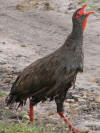
Porcupine, male red-necked spurfowl
As every day, I saw lions again, this time more than 10 in one big pride, all of them relatively young and beautiful, several of them not even adult, and some cubs.
Each day ends with a spectacular sunset, so here's today's sunset photo (and aren't you envious of those beautiful eyelashes):
The manager of Fig Tree kindly invited me to a bush dinner. There was a group of almost 40 professionals in various fields of the tourist business and NGOs (Non-Governmental Organizations) on a familiarization tour, for whom the bush dinner was done.
We were driven out at night to a place prepared with a big fire and the entire range of the food buffet that is normally offered in the lodge. It was nice, I chatted with several interesting people, and the last ones, including me, returned with the last carload at around 23 o'clock. I had been the one and only mzungu (European, white-skinned person) among the whole lot.

2003-06-02 Maasai Mara Nairobi
I left Fig Tree before sunrise and drove off into the dawn. At this time one can sometimes, with luck, see some nocturnal animals before they go to bed. One example is the bat-eared fox, a small, shy predator of the night.
On my way I saw one species of which there is no photo yet in this reportCoke's hartebeest. It looks a bit similar to a topi, but is light-brown, has a peculiar lyra-shaped horn, and when it looks at you, horns and ears create a funny double structure.
Way outside the nature reserve I see some wildebeest (gnu) and zebra (the common zebra, as opposed to the grevy zebra that can be seen in Samburu) and took some photos of these species as well. I hadn't actually seen many zebra this year.
Then came the very poor road around Narok and Ntulelei, which is a disintegrating paved road. These are worse than if they had never been paved in the first place. Part of the way people drive beside the road.
Eventually I crossed the Rift Valley again. The next photo shows a view across the valley from the west with the volcano Mt. Longonot visible on the left side.


Rift Valley, satellite communications station
Finally I reached Nairobi and went straight to the Aero Club again. The entire drive took a bit more than 8 hours.
It seems that this will be again one of the days when I pay more for the telephone than for the room, because the Internet connection is terribly bad. Here it's actually the modem link that works well. It's still not fast, typically between 24 and 28.8 Kbit/s, but at least it doesn't seem to break down. But the subsequent Internet connection is poor, almost nonexistent. Therefore you may see this page without some of the pictures until I manage to upload the whole lot. Bear with me, at the moment I'm only a victim of the expensive third world myself.
It's now past 23 o'clock and I have to give up for now. About half the new pictures got uploaded. I'll give it another try tomorrow morning. But it was an interesting, and costly, experience to see the this infrastructure problem of Kenya, after experiencing the dysfunctional roads for the other part of the day. If you want to have something working with high reliability and efficiency, you often have to bypass all Kenyan infrastructure functions. I would, for example, have to use a satellite phone and pay some foreign company, rather than paying the Kenyan Internet access provider SwiftKenya for several hours for a non-working connection. Interestingly, a satellite phone, in spite of its high per minute (or per Kilobyte with some companies) price, would have been cheaper in this particular case.
Inefficiency can mean wasting lots of money. Think of it this wayif a truck can only drive 40 instead of 80 km/h and can carry only half as much, then you need 4 trucks and 4 drivers instead of one, thus the price for trucks and fuel is 4 times as high and the driver salary may well be 1/4. Nonetheless you often hear the complaint in Kenya that there are not enough jobs, which in fact only indicates that something is hindering entrepreneurs to create them. I hope that the Kenyans aren't led down the blind alley of demanding all nice things directly from the government, similar to the stagnating Germany.
I ponder the thought why the Internet connection is so bad. It may just be incompetence or fraud at SwiftKenya, but another possible explanation could be lack of competition due to government meddling. The typical situation would be that the government invents a license, then licenses only very few operators, thereby stifling competition, creating a monopoly situation and the basis for licensing corruption, somewhat similar to the non-competitive telecommunications situation in Germany some ten years ago. But I don't have any firm information about this aspect, so it remains speculative.
In the restaurant I had a good dinner and read today's newspaper, particularly the Madaraka Day speach of the new Kenyan president Mwai Kibaki. He emphasized hard work. "Madaraka" translates into power to the peopleMadaraka Day is the anniversary of the British colonialists handing over power.
Today I had a leisurely morning and have planned to obtain my medical check, required for the pilot license renewal.
But first I find my junior roommate, a juvenile gecko. He's about 10 cm long. Later, when I enter the Aero Club, I find another small creature, but at around 12 cm actually somewhat larger than the gecko, a locust.
I drove the short distance to Nairobi Hospital, but they asked me to come back tomorrow because of too many patients that day. I asked for a slot this afternoon, and the clerk said, OK, come at three. So I continued to Rasul's to prepare my little jeep for the arrival of my family and convert it back from a two seater camping vehicle into a normal four seater jeep. I asked them about putting the spare tire back to the outside to get more luggage space, but it turned out that the extensive modifications they do to all these cars to make them feasible for the Kenyan bush make that impossible. The original spare tire holder would have obscured the license plate, and that could not easily be moved.
As an alternative they offered me the slightly bigger, softer, faster, newer Suzuki Maruti Gypsy, and after some consideration they offered to give it to me for the same price as the Sierra. Now that's an offer I could not refuse, so they pulled one out of their big car storage and prepared it for me. It even smells new. And it has retracting seat belts, 12 gears, rather than 10 (2 x 5 forward gears, 2 reverse gears), headreasts, a 1.3 l fuel injection engine and a roof hatch that folds forward rather than having to be stowed inside the jeep.
I then chatted for quite a while with Shahid Rasul about various topics, and one of the interesting things he showed me is how they modify the Suzuki Sierra for operation in Kenya after they receive it from Japan. It turns out that the Sierra, as delivered, has a great number of weak spots, so they do a complete overhaul and modification to the car before it gets into the hire business. They even talked to Suzuki about these things, but Suzuki wasn't overly interested, as only a small percentage of their jeeps actually gets the extremely hard use that they get in Kenya. Kenya is actually an ideal testing ground for jeeps.
Eventually I offloaded my few things from the Sierra, put them in the Gypsy, and drove off, back to the Aero Club for a small lunch. There I met the owner of the aeroplane I will be using for a flight to Lamu, and he told me that he has some little extra work for me to do there. Somebody in Lamu wants to do some aerial photography, and once I'm there, I might as well do it, rather than somebody having to fly this long way just for a short survey flight. I agreed, and so I will probably do an extra flight. This will also force me to go back via Malindi, as the plane does not have enough fuel to get back to Nairobi after that extra flight.
Then his secretary has an Excel question for me, but soon I have to be on my way again to the doctor for the medical check at three. As I back out of the parking lot, I notice that I have a flat tire. This gives me a chance to check whether the tools are appropriate and whether I can still change a tire in 10 minutes. Yes, I can. Everything works like a charm, and I discover a strange piece of metal that sticks firmly to the tire, punctured the tube, and is certainly the cause of the flat tire. It looks suspiciously like a piece that was made expressly for killing tires, but I can't think of any point on my short trip where this would have made any sense for anybody. My only stop was at the petrol station to fill the tank, but the thought that they wanted to generate some extra tire fixing business seems a bit far fetched. But I have certainly never seen such a tire killer device anywhere else in my life.
I get the medical examination without any problems and continue back to Rasul's to ask their advice about the damaged tire. They pull the metal out of the tire and attempt a repair, but the tube has a second puncture and finally requires an overly high balancing weight, so they end up giving me an entirely new wheel and keep the repaired one as a spare. They now have very new tire mounting and wheel balancing machines, so the work can be done quickly. And it cost me nothing.
This detail of the car in front of me I photographed on my way back to the Aero Club when we were stopping at a red traffic light.
In the early evening I discuss some details on the telephone of one bit of work to do on the elephant database that I plan to do tomorrow. Then I go to the Aero Club's restaurant for dinner.
Something went wrong with a planned delivery of a database copy, now planned for tomorrow. I went to the DCA (Director of Civil Aviation) office and filled in the forms for pilot license renewal. I'll get my renewed license tomorrow. On my way back I took a first photo for a matatus and buses series. Let's see how far I can get with this little subproject. Please see the matatu collection at the very end of this page.
I spent the rest of the day in the Aero Club doing various things like editing this report. At around 18 o'clock I went out onto the airfield and watched the evening rush of airplanes and some helicopters coming in to land or doing training circuits. I used to do this when I started flying here, but airplanes and flying have never ceased to fascinate me.
For dinner I went to the Aero Club's restaurant again and made a stupid mistake. I found Tiramisu on the menu and ordered it out of sheer curiosity. I didn't really expect to get any really good stuff, but I wanted to know.
Well, let's say I shouldn't have done that. The Tiramisu came partly frozen and tasted strange, in any case it didn't taste like Tiramisu. Because of the frequent electricity failures it has probably been thawed and refrozen 50 times and never been eaten because most people here know pretty well what to order and what to avoid. But I ate it anyway, which produced a predictable and thorough gut reaction.
I guess that one reason why I generally enjoy my good health is that I regularly go to Africa and get my battering of germs that may be important to keep the immune system on its toes.
In the evening I watched a little TV, and a panel discussion among some well known Kenyan politicians caught my attention. I find the current political climate in Kenya after the democratic change of government absolutely fascinating. At this time the openness, frankness, common sense, and closeness to the people appear to exceed by far those in the western democracies, where nothing moves any more. After the long era of a dominating single party the political climate in Kenya is now as good as it ever could be. Surely not all hopes will be fulfilled, but the signs of progress are obvious. My optimistic scenario is that there is an old Kenya, and in the midst of it a new, quite different and modern Kenya is now appearing and growing, borne by a new and modern generation.
Later I slept quite well, although my belly still felt a little stressed.
I started afresh with a light breakfast consisting of a can of thin tea and two slices of toast to have something in my intestines again. I actually feel quite well now.
A central project computer in Amboseli seems to have bitten the dust (perhaps in the truest sense of the word). This delays the database further and may shift it out of my work time window. I'll try to find out more.
Drove to the DCA again to collect my renewed license. No problems there.
I notice that it has been cool in Nairobi. Even though the sun often shines in the afternoon, I find myself walking around with a satin jacket over a shirt. I guess the air temperature at around 24C, but I'm now acclimatized, so perhaps my body generates less heat than it does back in Germany.
I suddenly got a little job to do in Amboseli, so I will try to hop on the commercial flightAir Kenyato Amboseli tomorrow early in the morning and will try to get a computer to work again.
For the sake of completeness, here's the GPS track of the last three days in Nairobi:

2003-06-03 to 2003-06-05 Nairobi
I woke up at 5:30 o'clock, took a shower, and separated my luggage into one part that would stay in the Aero Club and one smaller bag that would accompany me to Amboseli. Then I drove over to Air Kenya and asked for the flights.
They were nearly empty. The Cessna Caravan (1 turboprop engine, non-retractable gear, 12 passenger seats, 3 abreast, see photos below) had 4 passengers. I asked the pilot what he thinks about another pilot in the copilot's seat, and he agreed. So I could sit in front and have a wonderful view at Kilimanjaro above the clouds directly in front of us, as we flew to Amboseli at an altitude of 3 km above sea level.
I have a difficult task of getting a computer back to working order that no longer boots after a failed installation of some drivers. Just after I begin to work, the nearby Ol Tukai Lodge, from which the office gets its electricity, switches off its generator because there are hardly any guests anyway.
So one of the research assistants and I walk over and ask the manager to help us by switching it back on again. He is very friendly and agrees.
After several hours of complicated detective work I finally identify the offending driver and disable it through the repair console and the computer successfully boots again. After cleaning up a bit and uninstalling some unwanted drivers I hitch a ride with one of the researchers to the campsite where I fit my laptop into a typical camp working environment.

Computer workplace in the tent
Two big solar panels on the roof supply electricity to a big battery through solar controllers that prevent overcharging or deep-discharging the battery. An inverter produces 230 V of alternating current for the computer and other equipment, mainly chargers for the many batteries in other electronic equipment like GPS and digital camera.
I use part of the afternoon for some more work on the database and also for a chat with the photographer who is working on the Echo 3 movie.
I can't help taking another photo of the camp in the last sun rays under the magnificent mountain.
A dinner in the dinner tent with the researchers and a discussion of the work results concludes the day.
I get up very early, do the last bit of work and am driven to Amboseli airfield, where the Air Kenya plane arrives at 7:30.



The Cessna Caravan arrives at Amboseli
It is the same pilot, and this time the plane is entirely empty, except for the pilot and myself, so he invites me into the copilot's seat again, and we have another wonderful flight above, and later through the clouds to Nairobi Wilson.
I have to arrange several things, so I drive across Nairobi twice (and take more matatu photos, please have a look down at the end), then I drive to the international airport to collect my family. On the Mombasa road there is a traffic jam on the other side, but many drivers cross over to my side, and a traffic jam develops here as well. I drive some distance beside the road, following the unstoppable matatu drivers, and arrive at the airport in time to welcome the rest of the family, Mausi (Inge), Georg and Franz (Stephan).
They arrive in good mood and with all luggage and we drive "home" to the Aero Club. Two take a little nap, but Franz stays awake.
In the evening there is more rain. People tell me that it had rained last night as well. We have a good dinner in the club restaurant, then we go to bed.
We drove off just after sunrise and before breakfast.
But we drove into the Hotel at the waterfalls in Thika, Chania Falls, and had a nice breakfast there, with a view to one of the falls. Here's a photo after breakfast and just before driving on.
We tried the old road via Muranga and found it quite good, but some places were destroyed by water and now very slow to pass. In Muranga town we found a road that went up towards the Aberdares, then turned right to Nyeri. The normal road would have been a bit shorter and faster, but this one was interesting and led us high into the moist areas. We drove quite a bit of that way in drizzling rain and fog.
Eventually we reached Nyeri, joined the main road in Kiganjo and continued via Naro Moru and Nanyuki to Isiolo. A picture taken along the way:
Eventually we reached Buffalo Springs Game Reserve and ultimately Samburu Game Reserve. We saw a congregation of some 100 elephants. Some more photos:



Dwarf mongoose, monitor lizard, crocodile
We first took the monitor lizard on the fountain column for a sculpture, but it turned out to be a real one who just happens to love that place.
After a 7-course dinner we went to bed fairly early with the plan to do an early morning game drive tomorrow.

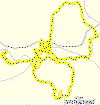
2003-06-08 to 2003-06-09 entering Samburu and game drives, 2003-06-10 Samburu game
drives
We had at least two game drives every day. Some of the time we didn't see anything that could be photographed, some of the time the light wasn't particularly good, but we enjoyed ourselves nonetheless, even though it cannot always be conveyed in photographs. We saw, but couldn't photograph, three cheetahs, a hunting lioness, more than 100 elephants, and many other animals. A few pictures:



Grevy zebra, elephants, secretary bird
On Wed, 11. June, we left early and drove back to Nairobi.
On our way we saw the Misty Morning Milk Bar:
We went straight to the Aero Club, as usual.
We used the morning to sleep longer and have a good breakfast. Only just before we started did somebody tell me that the fuel indicator for the right tank doesn't work. Indeed, the pointer remained solidly at its left stop and always showed zero. Since the plane has a slight tendency to have more fuel in the right tank when flying from both tanks, the normal procedure is to fly from the right tank first. Light aeroplanes have no aileron trim, and the tanks can substitute for that somewhat. This also gives us the method on the return flight to fly the right tank almost empty, then fly the rest from the left tank where we have a working fuel indicator. At least the Cessna 182, unlike the smaller 172, has rudder trim in addition to the normal elevator trim.
So we boarded our Cessna 182 and took off for Lamu.
![]()
2003-06-12 to 2003-06-15 Nairobi Lamu Nairobi
The flight goes over hundreds of kilometers of uninhabited thorn bush savannah, so we had a first aid kit, some emergency food, and drinking water for up to four days on board. Everybody got an emergency briefing including what to do and what not to do in case of an emergency landing out in the bush and also including the two most important radio frequencies to call (Nairobi Centre at 118.5 MHz and the international emergency frequency of 121.5 MHz) for help. We spoke about worst case scenarios like aircraft crashed and burned out, parents dead, things like that, and I'm sure we've got the important things covered.
The main point is not to try to walk through the bush, but to stay with the aeroplane and to stretch the water supply for at least four days by resting in the shade during the day to reduce sweating and doing what's necessary during the night. The plane will most likely be searched and found within two days after failing to show up as planned. I also had our exact route both on the flight plan and explained to somebody at Wilson, and I told them that we would fly over the remote areas precisely according to the GPS course, such that search and rescue missions would only have to search a small strip of a few kilometers left and right of our planned course.
But fortunately the engines are extremely reliable, and ours didn't fail this time. We flew out the northeast access lane, from there straight to and over Kitui, which has a big, paved airfield, then straight to Lamu island.
Some aerial photographs of Lamu town follow. In the first an area of differently colored, mostly red roofs is visible on the left side. This is the consequence of a devastating fire that Lamu experienced several years ago and that destroyed this part of the town. The newly built roofs are all of the same color that is different from the older roofs.


View from Lamu towards the Indian Ocean, view over the roofs of Lamu
Lamu was once, some 500 years ago, the most important port of east Africa, at a time when Mombasa or Dar Es Salaam didn't even exist. I always find Lamu fascinating, partly because it is like a time travel into the middle ages, with streets too narrow for a car, partly because of its fascinating people and atmosphere.
Most people in Lamu are Muslims, but there is also a lively Christian church. The two religions are very easy to distinguish in womens' dress code. For example, the first woman in the photo series, selling chickens, is a Christian, the others are Muslims.

Franz and Mausi at breakfast in the New Lamu Palace Hotel
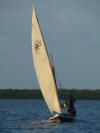
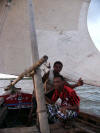
The fastest dhow of Lamu (the Hodi Hodi, second in a recent competition only to
another dhow from Pate island)


Sleeping cat, lobster dinner plate
We particularly enjoyed the sea food, the dhow sailing, and the strolls through this exotic town. What we didn't enjoy was being woken up every morning at 4:30, two hours before sunrise, by the muezzins who call the Muslims to their first prayer, using megaphone loudspeakers, something Muhammad certainly didn't have in mind in his time. In fact I would like to find out whether it was actually Muhammad or the Quran that prescribed this wake-up time or whether it is just the Islamic establishment terrorising the believers. I'll ask. It certainly lowers the productivity of the people and thus explains to a small part why Islam is a religion of the poor countries. Perhaps it even explains why terrorists tend to be Islamic, terror breeding terror. In Germany, waking up people with loudspeakers in the night is certainly against the law. Some time ago in Germany the rules against loud church bells were tightened, so people can sleep better. Recently even the beer garden opening hours in residential areas have been shortened to protect peoples' sleep. That is the exact opposite of what we experience in Lamu.
We had planned to take off again today and fly back to Nairobi with the help of a strong, favorable tailwind. However, the weather turned rather bad. Wave after wave of heavy rainshowers came down from low, dark clouds over Lamu, so we kept waiting for the weather to improve.
Only in the early afternoon did it stop raining, and we set off by boat to Manda Island. We packed the plane, filled an extra 40 l of petrol into the right tank, and got ready to start. However, as I tried to start the engine, there was a noise like a big spark in the back of the airplane, and since then the electric system of the plane was dead. No electricityI couldn't even raise the landing flaps again that I had lowered for inspection, not to mention starting the engine.
I called the person who knows this plane best from my mobile phone. (Yes, it works in Lamu.) We discussed what the cause could be and what I could do. We began a session of telephone calls interleaved with repair work. I began to dismantle the airplane. First I opened the battery compartment in the tail, then I removed the upper engine cowling.
After two hours of analysis and testing, removing parts, shortcutting contacts, pulling wires and interspersed telephone calls to the expert, then putting everything together again, the electric system worked fine again, but by now it was 16 o'clock and a tad too late to take off for Nairobi. The flight takes the better part of 3 hours and I don't want to take off without about one hour of daylight reserve.
Mausi showed her skills as an aircraft engineer. She put the engine cowling back on without much help from me. Good job, Mausi!
We locked the aeroplane again and caught a boat back to Lamu, where the hotel received us gladly for another night. We used the evening for a very nice dinner in yet another seafood restaurant and enjoyed it a lot.
This time I slept with earplugs, but the muezzins' loudspeakers were stronger, and I couldn't fall asleep again after the last one finished. They don't all begin their sermons at the same time, so it takes a while for them all to finish.
We rose after sunrise and went down for a last breakfast in Lamu. Then we set off in a small boat for Manda Island and the airfield.
We readied the airplane and tested the electricseverything still worked. Then came the biggest teststarting the engine, but it started without a hitch, and we took off into the next dark rain front, turning to the right to avoid flying into it. I tried to fly over Lamu, but the rain had already begun to engulf the town and we had to turn again, flying along the rain front to regain our course towards Kitui, then Nairobi.
We tried to climb above the clouds, but high buildups made this ever more difficult, so we gave up at 5,500 ft (1,650 m) and dived back to 2,500 ft (750 m), staying under the clouds for the rest of the flight and climbing slowly as the ground beneath us rose.
This time we had a favorable tailwind, which added nicely to our speed and saved us fuel. The flight was peaceful. We reached Nairobi at around 13 o'clock and went to the Aero Club restaurand for a good lunch.
After the temperatures and the high moisture of Lamu, at this cool time of the year some 27C in the early morning and varying around 30C on sunny days, Nairobi appeared decidedly cool to us. We spent the rest of the day unloading our cameras, sorting through the photos and uploading this report.
We have nearly run out of Kenya Shillings, partly because my calculation didn't fully appreciate how much four people can eat and drink, partly because a planned meeting, where we should have received another KSh8,700 had failed because of the Lamu delay. We scratched our last Shillings together and could just barely afford a breakfast in the Aero Club.
Then I met Ashif Lalani (the pilot), and while we chatted, he mentioned that there are now lots of ATMs (Automatic Teller Machines) in Kenya, at least four of them just outside Wilson Airport. So we made a tiny detour to an Uchumi supermarket and found two ATMs there. The first one didn't work with our cards, but the second one, run by Barclay's Bank Kenya, to my utter surprise accepted my first attempt with my ec Maestro card and asked me how many Shillings I would like, up to 20,000. I withdrew 10,000 in very new bank notes and didn't even test my credit card. This means that I no longer have to bring large amounts of cash into the country, except for the US dollars needed to pay some park entrance fees. Happily we drove off for a short meeting with one of the elephant researchers before continuing to Nakuru.
Originally we had intended to spend two nights at Lake Nakuru, then three nights in Maasai Mara, but while we drove and discussed our options it became clear that we all liked it more to skip Lake Nakuru altogether and instead spend all four remaining nights in Maasai Mara. Less driving, less packing, less settling in, more rest and more peace and last, and also least, lower cost, determined our decision.
We had our quick meeting, then continued along Limuru Road, crossing the main highway to Nakuru, and driving down into the Rift Valley.
![]()
2003-06-16 Nairobi Maasai Mara
Because we had left rather late, around 9:30, we drove as fast as we could without incurring any undue risk. First Mausi was to drive until the road got bad near Ntulelei, but she kept driving through the very bad part until Narok. There we stopped at the petrol station after the bridge, topped up the tank, and took some French fries and half cakes aboard to eat while driving.
Happily we drove on along the last bits of reasonably good paved road, then onto the sandy and stony track to Sekenani Gate. At the gate I learned that I have to pay the entrance fee for the near part of the park at the gate, but for the part beyond Mara River, like Mara Serena Lodge, I would have to pay there, usually at the lodge. We decided to stay on the near side and paid at the gate.
Then we drove on and turned off from the main track to the right into the bush about 4 km past the gate in the direction towards Fig Tree tented camp, our planned destination. This leads through a very beautiful area and changes the last part of the way into a nice game drive. It requires to cross two creeks, but I had already crossed these before.
As we drove slowly through the high grass, we saw a rain cloud in front of us, which, unfortunately, seemed to hover just in the direction of Fig Tree. As it was difficult to estimate the distance to the rain, we drove on to see where the rain actually came down.
As we had already driven about two thirds of the way to Fig Tree, it suddenly began raining some big drops. I looked around and saw that the rain had expanded towards us, so I decided to turn left and try to escape from the rain. But after a short distance the situation had changed such that more rain was now falling behind us, in the area we had just driven through. A few minutes later we were mostly engulfed by rain with a window to the northwest and a smaller, rapidly closing window to the southeast. These two windows were not very useful, because they required to cross creeks, but after a few more minutes we were already standing in pouring rain. I drove off the track into the grass and stopped the car, because I couldn't see much any more and because the track we had just driven on was now a pair of rivers with lots of water rushing down the slope.
We stood there, pondering our few options, for half an hour, until the rain got lighter, but it never stopped thereafter until hours later.
I decided that it was very risky to continue towards Fig Tree, because we still had one river and potentially swampy areas to cross, and with all the fresh rain that crossing would be very difficult. So we turned back in our own tracks, using the GPS. We went back through the one river crossing (the one over the stones, see earlier story above). It turned out that the stones were helpful even though they were wet and slippery, and we were able to cross back there. But on the other side there was a swampy area that had been difficult to cross before the rain, so we turned off again towards the east and headed in the direction of Mara Simba lodge to find the main track there, which is not as susceptive to rain as the smaller game drive tracks.
When we reached that track, we were only about a kilometer from Mara Simba lodge and discussed whether we should give up Fig Tree for now and spend one night there, but the family was very determined to reach Fig Tree, if at all possible. We decided to try to reach Fig Tree using the main tracks that don't require river crossings. So we turned right and headed back to the main track that we had left 4 km past the gate.
After three deep mud holes that we crossed by trying to keep two wheels on firm ground or on grass we reached the main track again and decided that our plan B was now no longer Mara Simba, but Keekorok, because we didn't feel like going back through those deep mud holes again. But plan A was still Fig Tree and we continued along the main track. Somewhere on this way I had giving up changing between two and four wheel drive and was now driving continuously in four wheel drive.

2003-06-16 Nairobi Maasai Mara, last few kilometers (last leg yellow)
I knew that the main track was good to drive even in rain, but the final entrance to Fig Tree had been impassable even before this rain, so we headed for a detour to the right, then along a smaller track roughly parallel to Talek River. That track, less than a kilometer from the lodge, proved the most difficult part of the whole trip. The black cotton soil had turned into a 10 cm deep and very slippery mud surface with deep holes and ditches dug by cars that had tried to pass through here earlier.
At one point we were sliding along, turning left and right with all wheels spinning but not gripping and the jeep becoming slower and slower, until we finally reached a patch of grass that gave some grip to the tires. This was the closest to getting stuck that day. The fact that the lodge was close is not much relief, because this is lion and hyaena country, and walking through the deep mud would have been unpleasant and difficult enough even without the predators. But we reached Fig Tree shortly before sunset and happily walked into the lodge.
To our surprise the lodge was dark and empty. After some time somebody appeared and explained to us that there were no guests. But we were welcomed and after ten minutes the whole lodge sprung to life, the generator was switched on, and we told the cook that we'd be happy with some chicken and chapati, so he wouldn't have to prepare the entire buffet just for us four people.
People welcomed me back, and I offered the lodge manager a movie on my computer. After the very good dinner I put my laptop into his private room, started the movie Gladiator and calculated that he would have to keep the generator running for half an hour longer than usual (10:30 instead of 10:00), so the computer's battery would last just to the end of this three-hour movie. I told him to just ignore the computer after the end of the movie, because it would switch itself off anyway after the battery runs empty. We also told the cook that we wouldn't go out for an early morning game drive and that nobody would show up for breakfast before 9:00, so the lodge crew could sleep longer as well.
Sorry, no photos. This trip was to difficult and I was also too afraid of the camera getting wet. In fact, the jeep was not even entirely waterproof. The rain entered our space in several places.
I enjoyed how the whole family was suddenly focussed on the common problem and working together to solve it, weighing arguments and counter-arguments, assessing and also accepting risks to find the best solution.
After a quiet night we rose in time for breakfast at 9:00 and enjoyed the tasty breakfast. I collected my computer and charged it in the car for two hours to be able to write this report. The generator is on between 13:00 and 14:00, so that would give us some more computer time if needed.
Then we went out for an afternoon game drive. Before sunset a very similar, but somewhat lighter rain could be seen to the east. We expected the rain to move towards Fig Tree and went back to the lodge in the evening sun to avoid it, but it petered out and only a few drops came down on the lodge.
On Wednesday we did three game drives. The mornings were all cloudy, the sun broke through only in the afternoons.
The following two GPS track maps show our diligence in tracking down interesting animals.

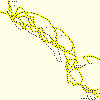
2003-06-17 (white) to 2003-06-18 (yellow) Maasai Mara game drives, overview, center
detail




Young vervet monkey, hippos in Talek River, a hyaena, still red from the blood of
its recent prey, lion
The last days in Maasai Mara were relaxing and peaceful. We drove around a lot and watched animals and other little things.

2003-06-19 Maasai Mara game drives

Hyaena in front of warthogs, zebras, and gazelles
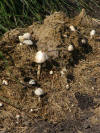
Mushrooms growing out of elephant dung
The most prominent predator was the cheetah, normally difficult to spot and not as frequently visible as lions. Once we found three small cheetah cubs. They are left alone by their mother when she goes hunting and they don't move unless one gets very close, because they are always at a very high risk to be killed by lions, hyaenas, or other cheetahs.

Cheetah cub in high grass, almost invisible
On our last day we saw several cheetahs. In the morning I saw them hunt, unsuccessfully. The stalked a herd of Thompson gazelles, which is by far their favorite prey, but the thommies were clever enough to stay behind a few topis who stand higher and can see the cheetah earlier. Also, the topi is not normally cheetah prey, because it is too big. Thus the topis warned the thommies, and the entire herd ran away in panic.
When cheetahs are discovered by their prey, they always immediately give up all attempts at stalking and hunting. They sit up and look after their running prey, then the turn in an entirely different direction to look for new, unsuspecting gazelles.
In the evening we found the family in the rightmost photograph, the mother with her two almost adult children that I already photographed earlier. We stayed with them into the night and left them only when it got almost completely dark.
This was the day of our return. In fact, the flight left only on Saturday at 0:45, but this means being there Friday night.
In the morning we passed by the same place where we had stayed with the three cheetahs the evening before, and indeed, they were still nearby, slowly walking through the high grass, then looking out for prey.
We stayed with them for a short while, then we drove out of the nature reserve, not without seeing yet another adult cheetah crossing our way on the grass plains. This one was darker than the others and of slightly more reddish-brown color, a very beautiful specimen.

2003-06-20 Maasai Mara Nairobi
The way back to Nairobi took about 8 hours, partly because one stretch of very bad road between Narok and Ntulele had been repaired in these few days. But the road on the eastern side of Ntulele remains very bad and steals time and some nerves.
On the way back up the eastern slope of the Rift Valley we saw women toting firewood, a typical sight in many parts of Kenya.
We drove to the Aero Club to take a shower, redress, and have dinner. At around 21:00 we drove to the Rasul home place to have our jeep bill finalized and to have Shahid take us to the international airport and take back the jeep. Our flight left in time at 0:45 on Saturday.
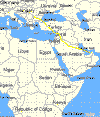
Route from Dubai to Munich, avoiding Iraq
The airliner was full, coming from Dar es Salaam, so we could hardly sleep. Only Franz managed to sleep for a few hours, stretched a little bit over two seats. In the morning, after sunrise, we arrived in Dubai and had an hour and a half to change planes.


MacDonalds in Dubai airport, a Dubai suburb seen from the air
The longer flight from Dubai to Munich was also fairly full. Before takeoff the plane had to wait in line, because many planes, almost all painted in Emirates colors, were taking off in all directions, to Asia, Europe, and Africa.
There was only one free window seat, so I took that and left my seat to my family, so at least one of my sons could spread himself over two seats (and Mausi's lap) and sleep a little.
Then Florinda, a beautiful and intelligent blonde, came to me and chatted with me till Munich. She even painted a picture for me:
I guess she was 10. (Florinda, wenn du dies liest, bitte sende mir eine Email.)
Soon enough we arrived in Munich and were collected at the airport by our helpful neighbors.
Another journey to Africa has ended. It will not be the last.
[Here's a final remark about my new Panasonic Lumix DMC-FZ1 camera. I consider it a full success. It worked as well as I had hoped. I like this camera and will keep it for the next couple of years.
The two shortcomings I can think of are its limited resolution at 2 Megapixels, i.e. no large, sharp prints, and its inability to work in very low light situations. But for me they are outweighed by the long, sharp, large aperture zoom (1 : 2.8 over the full zoom range), the image stabilizer, and its very small size and weight, compared to what I used before. I recently did some tests and found that for 2 Megapixels the zoom is sharp even at max zoom and max aperture. And at its price I will not complain anyway.]
If in this text you find any typos, orthographic errors (even small ones), ungrammatical sentences, wrong or illogical information (like wrong names of birds), if you want me to write more details about something in particular, or if you want one of the photos in full resolution (usually 1,600 x 1,200 pixels), please click on the email sign below and write to me. Many thanks!
Copyright 2003-2023 Hans-Georg Michna.
Private homepage – Hans-Georg Michna
Kenya travel reports: 1999, 2000, 2002, 2003, 2004, 2005, 2006, 2007, 2008, 2009, 2010, 2011, 2012, 2013-Goma, 2013, 2014, 2015, 2016, 2017, 2018, 2019
Kenya Safari Travel Plan, Kenya 1980-2000 photos
hits since 2007-11-01
Free PHP scripts by PHPJunkYard.com